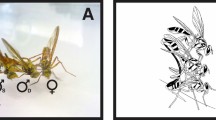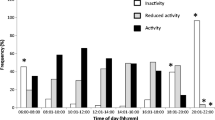Abstract
The mating success of individually marked male Mediterranean fruit flies was monitored over 6 consecutive days in the laboratory. Mating frequency was nonrandom, as the numbers of both males that failed to mate and males that mated many (more than four) times were much higher than expected by chance alone. Differential mating success resulted in part from intermale variation in activity level. Male copulatory success was positively correlated with the numbers of courtships performed, attempted copulations (mountings), and females courted. Male-male aggression, on the other hand, and a negligible effect on male mating success. Female choice also appeared to influence male mating frequency. Fewer than 10% of courtships resulted in mating, and in most cases females terminated courtship by simply moving away from the male. Females that did mate generally selected males having higher copulatory scores than previously rejected males.
Similar content being viewed by others
References
Apollonio, M., Festa-Bianchet, M., and Mari, F. (1989). Correlates of copulatory success in a fallow deer lek.Ecol. Sociobiol. 25 89–97.
Arita, L. H. (1979).The Mating Competitiveness and Quality Control of the Laboratory Reared Mediterranean Fruit Fly Ceratitis capitata(Wiedemann), Unpublished M.S. thesis. University of Hawaii, Honolulu.
Arita, L. H., and Kaneshiro, K. Y. (1982). Reproductive and sexual maturity of the Mediterranean fruit fly,Ceratitis capitata (Wiedemann).Proc. Hawaii. Entomol. Soc. 24 25–29.
Arita, L. H., and Kaneshiro, K. Y. (1985). The dynamics of the lek system and mating success in males of the Mediterranean fruit fly,Ceratitis capitata (Wiedemann).Proc. Hawaii. Entomol. Soc. 25 39–47.
Arita, L. H., and Kaneshiro, K. Y. (1986). Structure and function of the rectal epithelium and anal glands during mating behavior in the Mediterranean fruit fly male.Proc. Hawaii. Entomol. Soc. 26 27–30.
Arita, L. H., and Kaneshiro, K. Y. (1989). Sexual selection and lek behavior in the Mediterranean fruit fly,Ceratitis capitata (Diptera: Tephritidae).Pac. Sci. 43 135–143.
Boake, C. R. B. (1989). Correlations between courtship success, aggressive success, and body size in a picture winged fly,Drosophila silvestris.Ethology 80 318–329.
Borgia, G. (1979). Sexual selection and the evolution of mating systems. In Blum, M. S., and Blum, N. A. (eds.),Sexual Selection and Reproductive Competition in Insects, Academic Press, New York, pp. 19–80.
Burke, T. (1983). Behavioral ecology of mating in the Caribbean fruit fly,Anastrepha suspensa (Loew) (Diptera: Tephritidae).Fla. Entomol. 66 330–344.
Feron, M. (1962). L'instinct de reporduction chez la mouche mediterranean des fruitsCeratitis capitata Wied. (Diptera: Trypetidae). Comportement sexuel. Comportement de ponte.Rev. Path. Veg. Entomol. Agr. Fr. 41 1–129.
Hendrichs, J., and Hendrichs, M. A. (1990). Mediterranean fruit fly (Diptera: Tephritidae) in nature: Location and diel pattern of feeding and other activities on fruiting and non-fruiting hosts and non-hosts.Ann. Entomol. Soc. Am. 83 632–641.
Kaneshiro, K. Y. (1989). The dynamics of sexual selection and founder effects in species formation. In Giddings, L. V., Kaneshiro, K. Y., and Anderson, W. W. (eds.),Genetics, Speciation, and the Founder Principle, Oxford University Press, New York, pp. 279–296.
Kimsey, L. S. (1980). The behaviour of male orchid bees (Apidae, Hymenoptera, Insecta) and the question of leks.Anim. Behav. 28 996–1004.
Lederhouse, R. C. (1982). Territorial defense and lek behavior of the black swallowtail butterfly,Papilio polyxenes. Behav. Ecol. Sociobiol. 10 109–118.
McClain, D. K., and Marsh, N. B. (1989). Male copulatory success: heritability and relationship to mate fecundity in the southern green stinkbug.Nezara viridula (Hemiptera: Pentatomidae).Heredity 64 161–167.
Moore, A. J. 1989. Sexual selection inNauphoeta cinerea: Inherited mating preference?Behav. Genet. 19 717–724.
Parker, G. A. (1983). Mate quality and mating decisions. In Bateson, P. (ed.),Mate Choice. Cambridge University Press, Cambridge, pp. 141–166.
Poramarcom, R., and Boake, C. R. B. (1991). Behavioral influences on male mating success in the Oriental fruit fly,Dacus dorsalis Hendel.Anim. Behav. 42 453–460.
Prokopy, R. J., and Hendrichs, J. (1979). Mating behavior ofCeratitis capitata on a field-caged host tree.Ann. Entomol. Soc. Am. 72 642–648.
Robacker, D. C., and Hart, W. G. (1985). Courtship and territoriality of laboratory-reared Mexican fruit flies,Anastrepha ludens (Diptera: Tephritidae), in cages containing host and non-host trees.Ann. Entomol. Soc. Am. 78 488–494.
Robacker, D. C., Mangan, R. L., Moreno, D. S., and Tarshis Moreno, A. M. (1991). Mating behavior and male mating success in wildAnastrepha ludens (Diptera: Tephritidae) on a field caged host tree.J. Insect Behav. 4 471–487.
Shelly, T. E. (1987). Lek behavior of a Hawaiian Drosophila: Male spacing, aggression and female visitation.Anim. Behav. 35 1394–1404.
Sivinski, J. (1989). Lekking and the small-scale distribution of the sexes in the Caribbean fruit fly,Anastrepha suspensa (Loew).J. Insect. Behav. 2 3–13.
Spieth, H. T. (1968). Courtship patterns and evolution of theDrosophila adiastola andplanitibia species subgroups.Evolution 32 435–451.
Tanaka, N., Steiner, L. F., Ohinata, K., and Okamoto, R. (1969). Low-cost larval rearing medium for mass production of Oriental and Mediterranean fruit flies.J. Econ. Entomol. 62 967–968.
Watt, W. B., Carter, P. A., and Donohue, K. (1986). Females' choice of “good genotypes” as mates is promoted by an insect mating system.Science 233 1187–1190.
Webb, J. C., Calkins, C. O., Chambers, D. L., Schwienbacher, W., and Russ, K. (1983). Acoustical aspects of behavior of Mediterranean fruit fly,Ceratitis capitata: Analysis and identification of courtship sounds.Entomol. Exp. Appl. 33 1–8.
Whittier, T. S., Kaneshiro, K. Y., and Prescott, L. D. (1992). Mating behavior of Mediterranean fruit flies (Diptera: Tephritidae) in a natural environment.Ann. Entomol. Soc. Am. 85 214–218.
Wiley, R. H. (1973). Territoriality and non-random mating in sage grouse,Centrocercus urophasianus.Anim. Behav. 6 85–169.
Author information
Authors and Affiliations
Rights and permissions
About this article
Cite this article
Whittier, T.S., Nam, F.Y., Shelly, T.E. et al. Male courtship success and female discrimination in the mediterranean fruit fly (Diptera: Tephritidae). J Insect Behav 7, 159–170 (1994). https://doi.org/10.1007/BF01990078
Accepted:
Issue Date:
DOI: https://doi.org/10.1007/BF01990078




